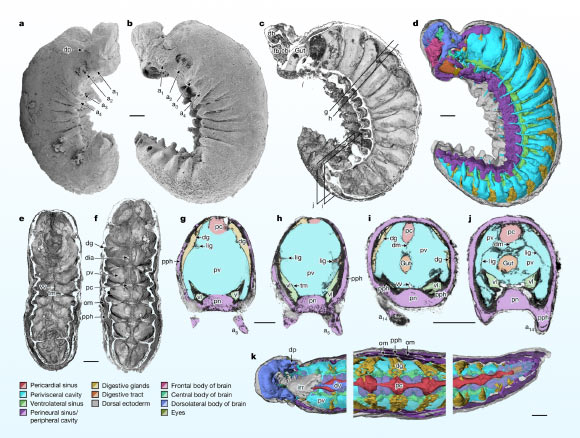Named Youti yuanshi, the newly-identified euarthropod species fills an important gap in our understanding of how the arthropod body plan originated and became so successful during the Cambrian explosion.
An anatomical overview of Youti yuanshi. Image credit: Smith et al., doi: 10.1038/s41586-024-07756-8.
Youti yuanshi lived during the Cambrian period, over 520 million years, when the major animal groups we know today were first evolving.
The species belongs to a group called Euarthropoda, which includes modern insects, spiders and crabs.
No bigger than a poppy seed, Youti yuanshi has its internal organs preserved in exceptional quality.
Durham University paleontologist Martin Smith and his colleagues used advanced scanning techniques of synchrotron X-ray tomography to generate 3D images of Youti yuanshi’s miniature brain regions, digestive glands, a primitive circulatory system and even traces of the nerves supplying the larva’s simple legs and eyes.
“When I used to daydream about the one fossil I’d most like to discover, I’d always be thinking of an arthropod larva, because developmental data are just so central to understanding their evolution,” Dr. Smith said.
“But larvae are so tiny and fragile, the chances of finding one fossilized are practically zero — or so I thought.”
“I already knew that this simple worm-like fossil was something special, but when I saw the amazing structures preserved under its skin, my jaw just dropped — how could these intricate features have avoided decay and still be here to see half a billion years later?”
“It’s always interesting to see what’s inside a sample using 3D imaging, but in this incredible tiny larva, natural fossilization has achieved almost perfect preservation,” said Dr. Katherine Dobson, a paleontologist at the University of Strathclyde.
“Studying this ancient larva provides key clues about the evolutionary steps required for simple worm-like creatures to transform into the sophisticated arthropod body plan with specialized limbs, eyes and brains.”
“For example, the fossil reveals an ancestral ‘protocerebrum’ brain region that would later form the nub of the segmented and specialized arthropod head with its various appendages like antennae, mouthparts and eyes.”
“This complex head allowed arthropods to take on a wide range of lifestyles and become the dominant organisms in the Cambrian oceans.”
“Details like these also help trace how modern arthropods gained their incredible anatomical complexity and diversity and came to be the most abundant group of animals today.”
The findings were published in the journal Nature.
_____
M.R. Smith et al. Organ systems of a Cambrian euarthropod larva. Nature, published online July 31, 2024; doi: 10.1038/s41586-024-07756-8

